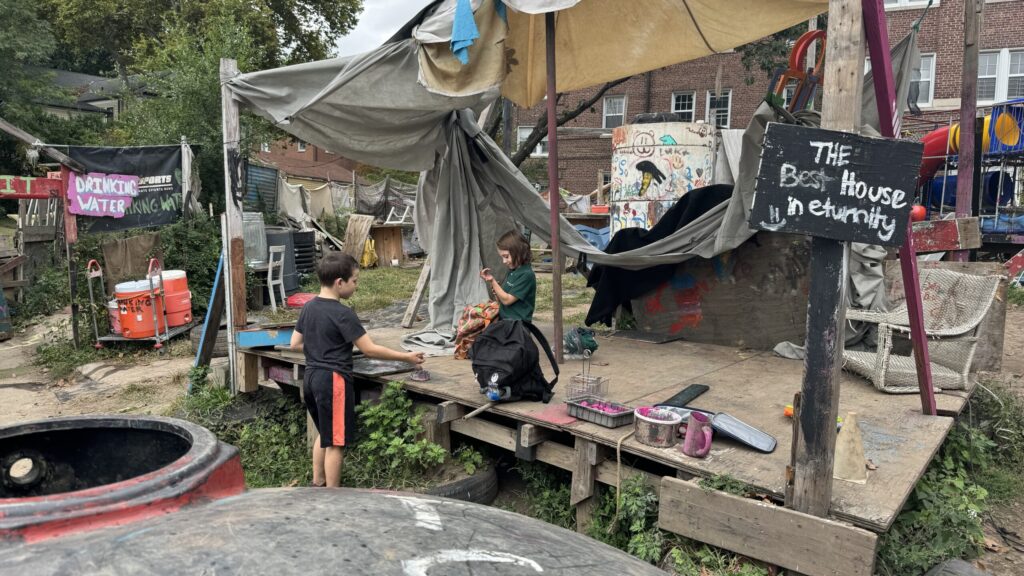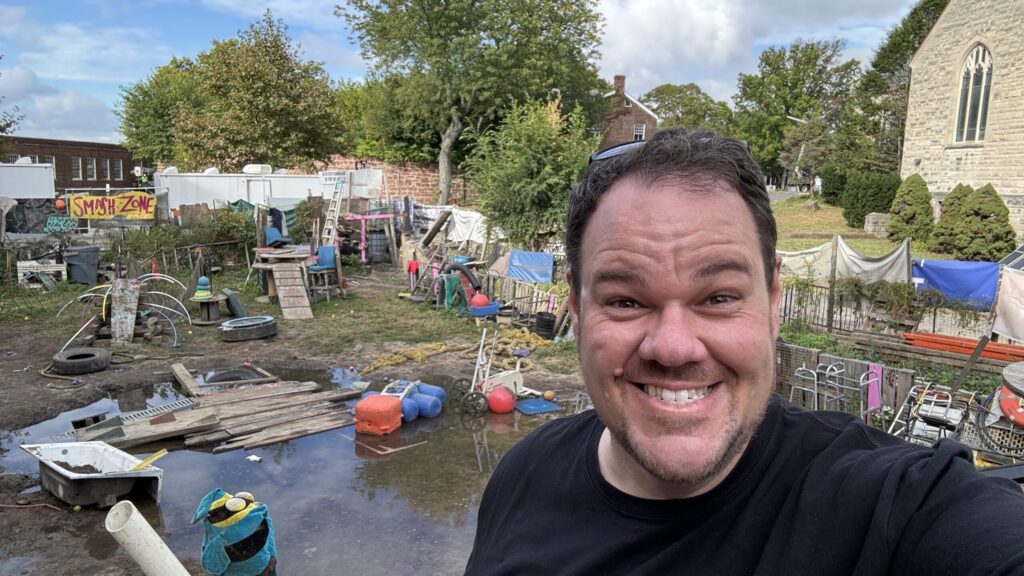During my recent visit to The Yard, Play:Ground NYC, I spent a day immersed in the world of Playwork with Yoni Kallai, Co-Founder, Head Playworker, and Interim Director. The sessions that I had the honour of being involved with – a school field trip and an afterschool program – offered deep insights into the impact of play and the way children play when adults actually just get out of the way. As a visiting Playworker, I experienced how The Yard’s mission and values align with the Playwork Principles, fostering an inclusive space where children feel empowered, secure, and free to explore on their own terms.
The Yard began in 2016 on Governors Island as New York City’s only adventure playground, part of a global tradition that dates back to the first adventure playground (or junk playground) in Copenhagen in the 1940s. Early iterations of these playgrounds emerged in the United States in 1949, and several flourished in New York City during the 1970s. The concept invites children to engage with their environment by giving them access to open-ended materials—often reclaimed from waste streams—and full freedom to build, destroy, and alter the space.
Since its founding, The Yard has welcomed thousands of children, creating an evolving play space shaped by the dreams and efforts of the young people who play there. The site is a dynamic landscape, filled with loose parts and tools, all under the guidance of trained Playworkers who facilitate, but do not direct, play. Children have full ownership over how the space is used, and the result is a constantly shifting environment where they can explore, take risks, and express themselves freely. This fact is palpable in the very nature of the environment that changes and morphs over time.
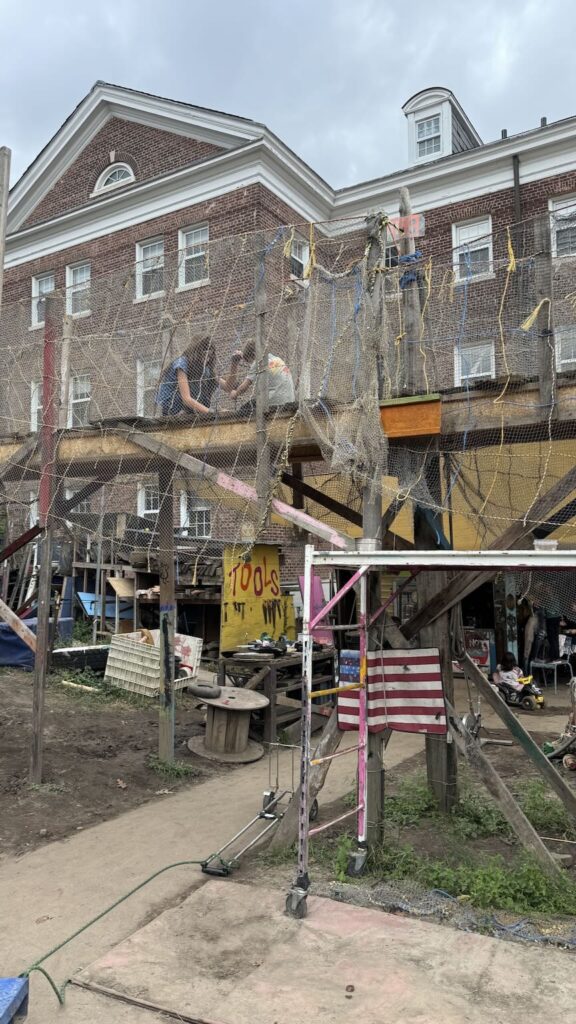
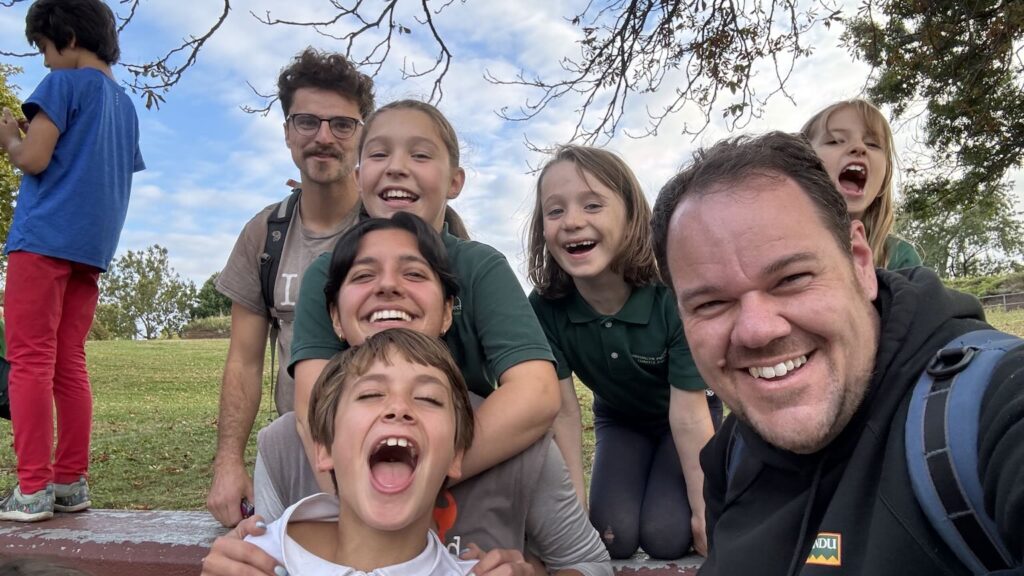
Reminiscing
Returning to The Yard was a full-circle moment for me. When Trudi and I first visited in 2016, we interviewed Morgan Leichter-Saxby, one of the original playworkers (read more here). It was inspiring to see how much the space has evolved – both physically and in the depth of its programming – while staying true to its mission of fostering child-led play (which is actually simply – PLAY). It looked so incredibly different from my first visit (and from the photos and videos I had seen of the space in the years since). This was a place that had stories, intrigue and a rich tapestry of culture built in. I entered the space, after meeting Yoni at the ferry terminal and catching the ferry over to Governors Island, with eyes wide and jaw dropped. It was so much more rich and dynamic than the first time I had visited and even though there were no children in the space when we arrived, it was so obviously a place of children! The avid forensic playworker (thanks Marc Armitage) would have a field day in this space, exploring and unpacking the myriad of play-frame remnants here.
Playwork Principles in Action
During my visit, Yoni and I reflected on the importance of maintaining child-led spaces and the critical role of advocacy in ensuring these environments are preserved. These conversations connected deeply with the work we do at Educated by Nature, especially through our KIN Village School Holiday programs. Like The Yard, our KIN Village programs (that act as pop-up adventure playground-esque spaces) allow children to take ownership of their play, offering them leadership opportunities and encouraging exploration.
Playwork and Adventure Playgrounds follow a set of 8 Playwork Principles. The Yard embodies these principles, fostering a vibrant space where children feel a sense of belonging and autonomy. Watching the children take ownership of their environment reminded me of how play, when truly child-led, becomes a powerful tool for growth and development. We see the same outcomes in our KIN Village programs, where children naturally assume leadership roles when given the freedom to play their way. Some of our discussions focused on how neurodiverse children, particularly, benefit from these environments, where they are free to play and succeed on their terms and through these opportunities get an opportunity to live into their gifts. Those aspects of the way their brain works, the way they process information, problem solve and create, become superpowers in a space like this and they become the leaders – in play, in creation, in innovation, in being a child!
Please note: The Playwork Principles are held in trust for the UK Playwork Profession by the Scrutiny Group that acted as an honest broker, overseeing the consultations through which they were developed.
Playwork Principles:
- All children and young people need to play. The impulse to play is innate. Play is a biological, psychological and social necessity, and is fundamental to the healthy development and wellbeing of individuals and communities.
- Play is a process that is freely chosen, personally directed and intrinsically motivated. That is, children and young people determine and control the content and intent of their play, by following their own instincts, ideas and interests, in their own way for their own reasons.
- The prime focus and essence of Playwork is to support and facilitate the play process and this should inform the development of play policy, strategy, training and education.
- For Playworkers, the play process takes precedence and Playworkers act as advocates for play when engaging with adult led agendas.
- The role of the playworker is to support all children and young people in the creation of a space in which they can play.
- The playworker’s response to children and young people playing is based on a sound up to date knowledge of the play process, and reflective practice.
- Playworkers recognise their own impact on the play space and also the impact of children and young people’s play on the playworker.
- Playworkers choose an intervention style that enables children and young people to extend their play. All playworker intervention must balance risk with the developmental benefit and wellbeing of children.
Zones/Spaces/Affordances
The physical space at the Yard is so diverse and rich with opportunities. Included in the space were areas that included the ‘Smashing Zone’, an epic tall structure called ‘sky fort’, a space for under 5s (which is primarily used on weekends and is the only place where adults are permitted entry), a mud pit (that was much larger, more like an ocean, on this particular day as a hose was left dripping overnight), the remnants of a zipline (that was under re-construction; I got to help with the initial stages of this re-build) a very tall bridge, a stage space, a music shed, resource stores and tool shed; to name a few.
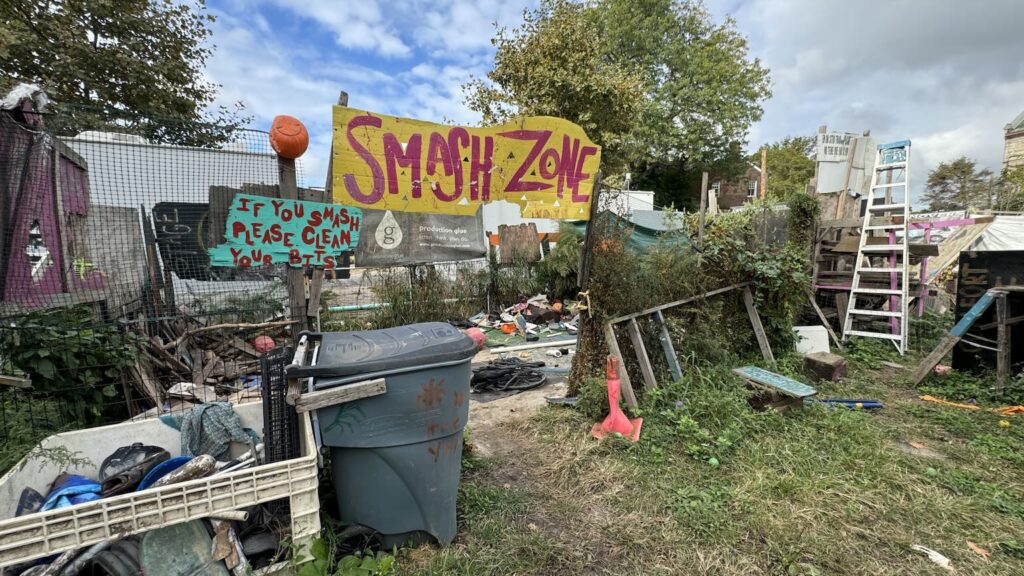
The Smashing Zone was one of my favourite spaces, and you can see from the evidence in this space, a well-used area for the children who inhabit The Yard. Literally, a sectioned off space at the edge of The Yard for smashing things! Smashing, deconstruction, breaking things apart is a regular feature on an Adventure Playground and often this type of play occurs anywhere. The Playworkers at The Yard, however, have made a decision to designate a Smashing Zone due to the fact that they have various sessions and ‘programs’ (used very loosely as a term to describe the different ways people can enter the space) and the way the areas are used varies dependent on its user. In the space are things like hockey sticks, bats, poles, batons, wooden stakes. Depending on the program, this space also may have things like hammers and saws to use for deconstruction also! This is not to say that deconstruction doesn’t happen anywhere else at The Yard, just more specifically smashing! This is a wonderful example of Principle 6, 7 and 8 at play!
This smashing zone also takes into consideration that The Yard is somewhat of a destination adventure playground, in that although it still follows the ‘three frees’, it is not situated within a community who have regular and easy access to it. It’s not across the road, or around the corner from children’s houses and there is more intention needed to ‘get here’ than your average community based adventure playground (like The Land, The Venny, Joomunjie Land, to name a few). Therefore, it is visited and inhabited by a more diverse range of children on a less regular frequency. For this reason, I feel that the relegation of the Smashing Zone as a specific place for whole body, high energy, deconstruction space makes sense. On non destination-based Adventure Playgrounds, situated in local community, this type of deconstruction often happens more naturally throughout the whole space.
The photos I collected while in this space are magical, to my eyes. I was awestruck entering the Yard, by the pure potential of the space. However, this is not every adult’s interpretation or reaction when they see the images of Adventure Playground and Junk Playgrounds. These do not meet the typical aesthetic of adults. Mess – it’s the aesthetic of childhood of play, of opportunity. I don’t really like using the word mess or messy either, as those words have negative adult connotations. It’s in the haphazardness of the space, the ‘mess’, the disorganisation, the chaos, the broken-ness of things where the beauty is. And this place is BEAUTIFUL!
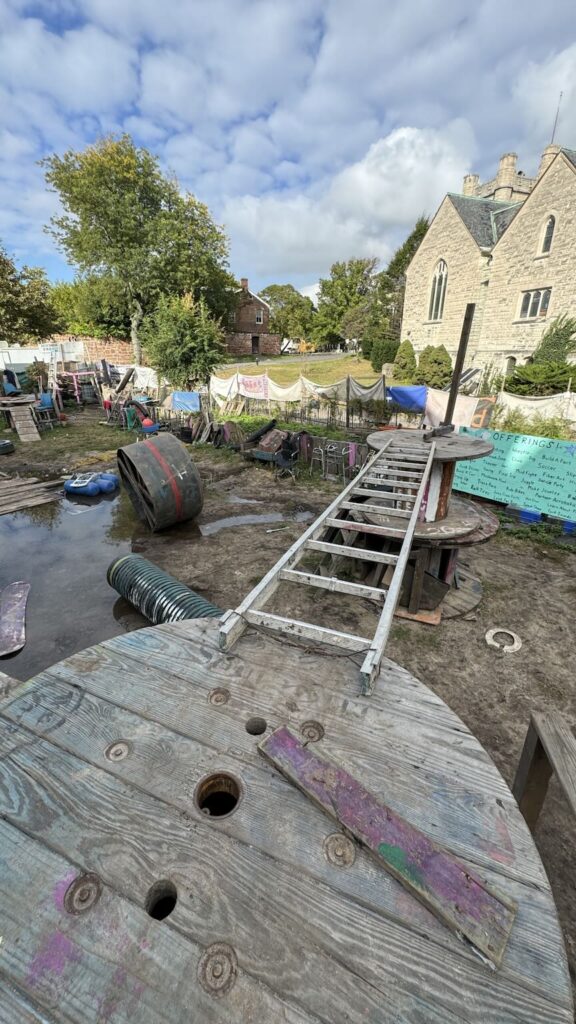
Risk
While at The Yard, I witnessed a child (of about 9 years of age) climb to a platform that would have been at least 3 metres off the ground, with a mattress or two positioned below. He had seen a number of children launch off many times before he climbed up and you could see he got to this position with somewhat of an intent to follow suit, however, when he stepped out onto the little ledge, he was tentative. In fact, several times he stepped back and ‘changed his mind’. It was so fascinating to watch this Dynamic Risk Benefit Assessment happening right in front of my eyes. (See this article on risk willingness, assessment and capacity). The cognitive processing, executive function and risk analysis happening in that boy’s brain (and body) was very clear.
At one point, while out on the ledge, with his peers supporting him with encouragement, holding the space that he needed for this experience, the boy called out to Yoni, who was working on something over the other side of the space. “Can I jump off here?” the boy called out. Yoni’s response was one of the best responses from a Playworker I have ever heard: “some people jump off there”. The boy pondered; a few moments passed. “Will I get hurt if I jump?” the boy asked Yoni, and in a similar, strong but calm response: “Some people have hurt themselves and some people haven’t”. This was such a brilliant response. It was a clear answer for the boy. It stated facts, didn’t sugar coat things, and best of all, didn’t provide a judgement call. In no way did Yoni’s response encourage or discourage the boy to jump. The information he provided placed the decision right back in the boy’s hands.
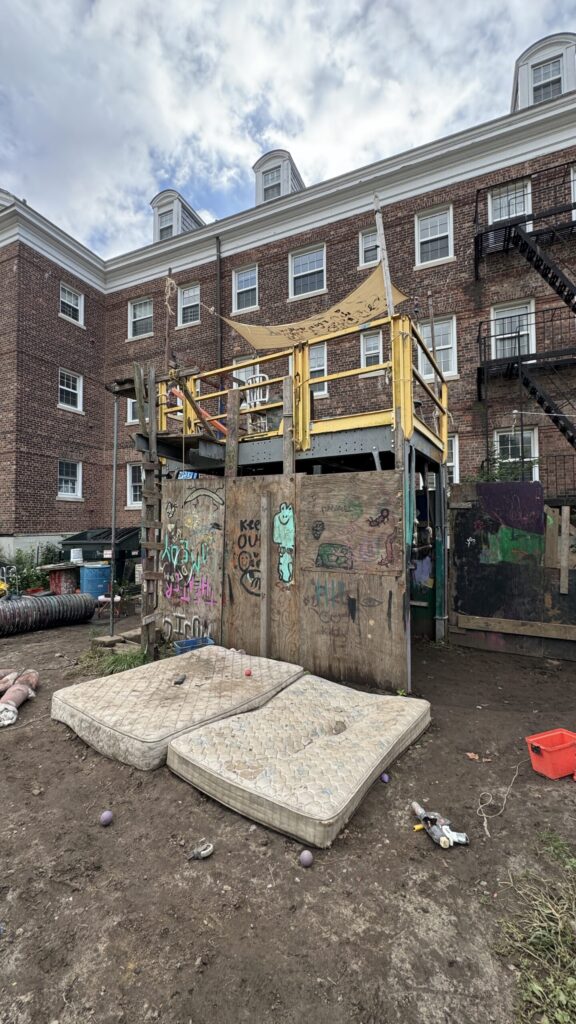
In asking the question, one could assume he was seeking ‘permission’ to jump and in giving permission, Yoni would have been disarming the boy and taking away his opportunity to listen to his internal feedback (interoception, anxiety, common sense, adrenaline seeking etc). This was pure, unadulterated opportunity to develop an internal check point of fear vs exhilaration (Ellen Sandsetter calls this Scary Funny and is the underlying feature of her research on Risky Play). The boy did jump, but not straight away. I witnessed him climb down twice more in the next 20 minutes and then in the final moments of his class’s session he jumped! I think he surprised himself, and by the look on his face, I don’t think he would have done it a second time that day, but what an incredible opportunity for him to learn about his body, risk, self-trust, discomfort, bravery, challenge, exhilaration, success and JOY! Even if he hadn’t have jumped that day, this still would have been a successful experience for him.
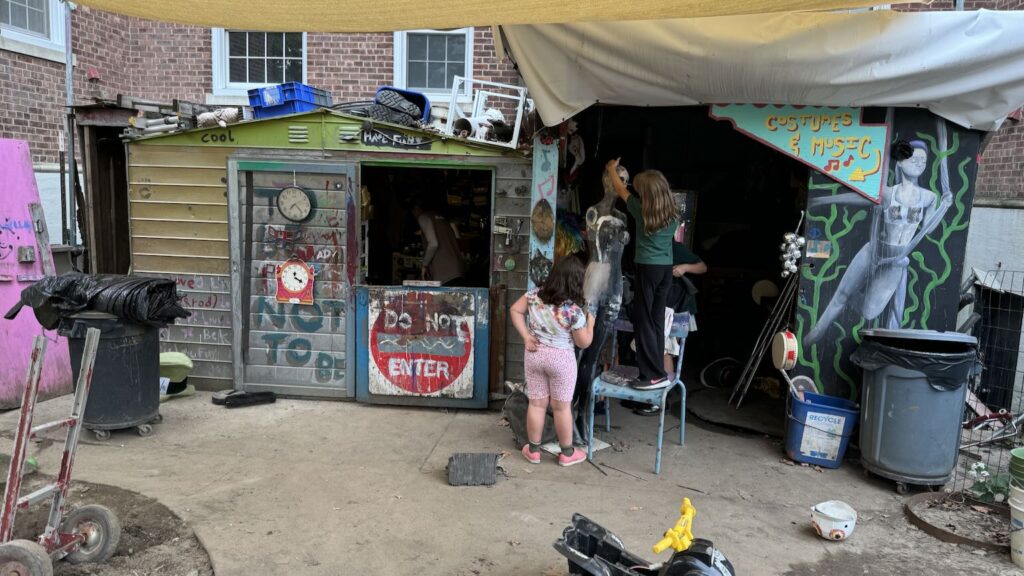
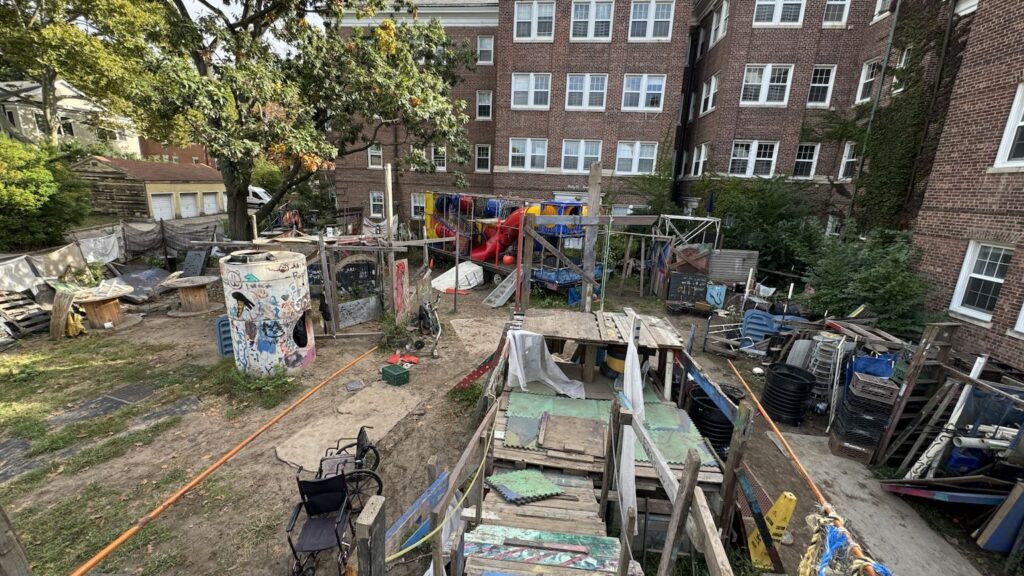
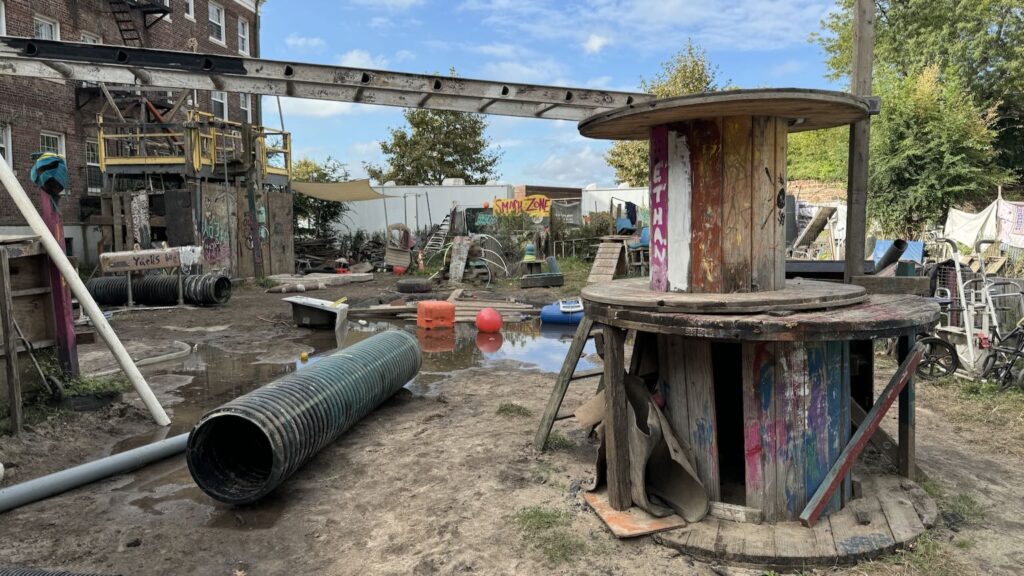
Sustainability – Repurposing New York’s Waste
As you can imagine, a city like New York produces A LOT of waste each and every day. Yoni and The Yard’s commitment to sustainability means that there is a constant search for suitable ‘trash’ to rescue from waste collection to bring to the yard. I especially loved the idea that with so many corporate events, large launches, fancy parties and the like that happen all across New York, The Yard works closely with some event organisers to make use of ‘single use’ events elements that are often used for decoration, aesthetic design and novelty. Often these objects and items are multiples of things, which is always exciting and beneficial for the junk playground environment.
What a wonderful way to make a small difference for the environment and protect all of that stuff from landfill!
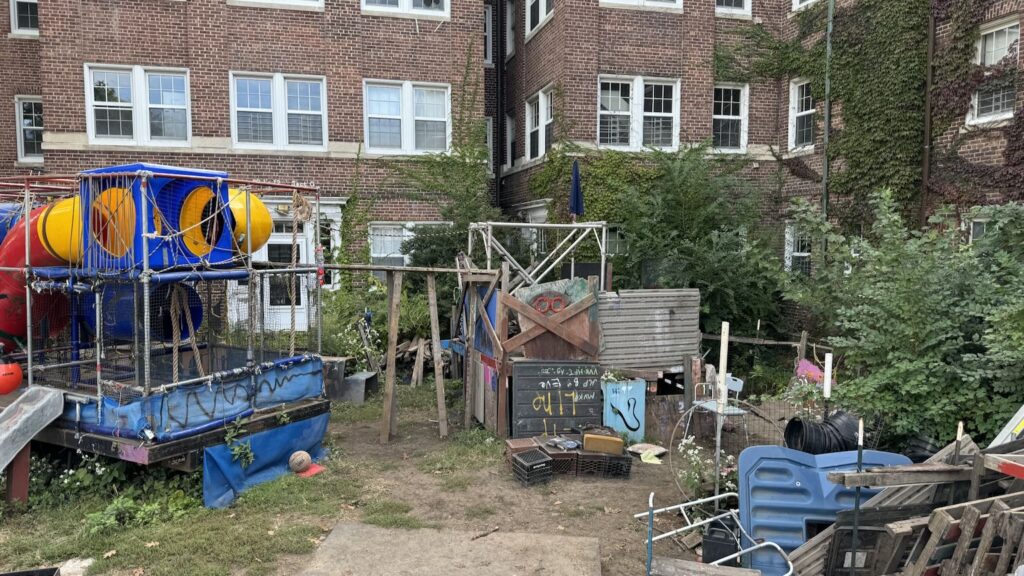
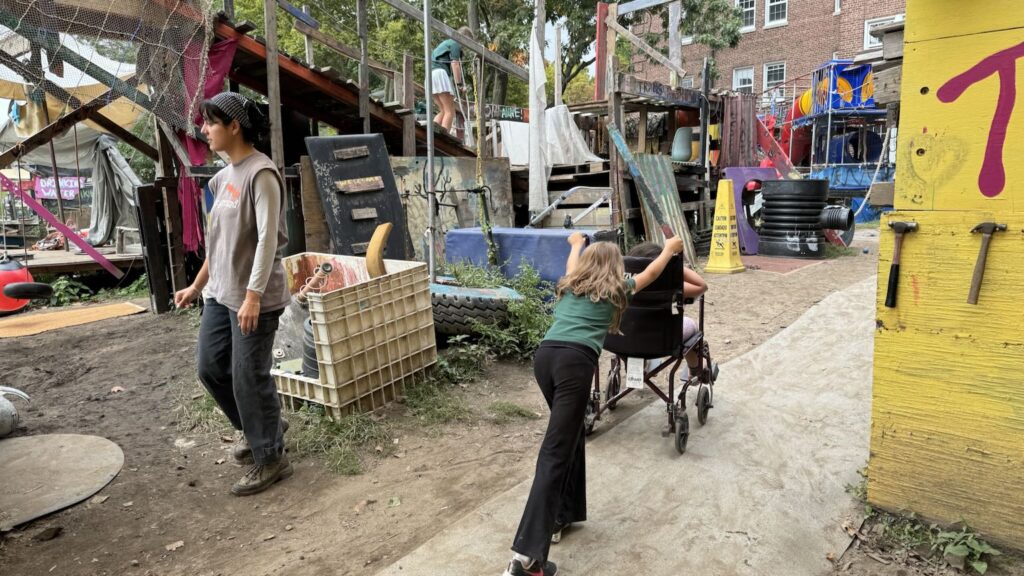
Things with Wheels
I really appreciated the variety and number of items in the space with wheels! Wheelchairs, trolleys, bikes, scooters, etc. Objects that can transport, move, roll and spin! They provide an incredible variety to the space, add to the affordances of play and give an incredibly dynamic aspect to the play that occurs. During my visit there were children giving other children rides in wheelchairs, inventing contraptions with bike wheels, transporting heavy things on trolleys and moving around the space in a giant hamster wheel made from half a water tank and wooden posts!
No Adults Allowed!
The morning session I witnessed was a field trip. A group of elementary school students (grade 5) who had come to visit Governors’ Island and The Yard. My favourite part of this field trip was the fact that after Yoni gave his introductory welcome – which was simple, brief and essentially just asked the kids to look out for each other and to have FUN! – Yoni then let the students in to the space and pointed the adults/teachers to the picnic benches across the road! The Yard is an adult free space, a space where the only grown-ups allowed in are Playworkers, adults with specific training in the Playwork Principles and an understanding of their role when it comes to play – to uphold the Playwork Principles and protect Play! As Martin King Sheard said in our recent Playwork Practitioner Training “Playwork is the art of working with the playing child”. When parents, teachers and other adults enter this space, they adulterate (a key Playwork term) and get in the way of play. With them ‘out of the picture’ children actually PLAY!
What was fascinating to watch across the field trip session and the afternoon session was the way in which the children played. Their use of the space and their play cycles were quite different to each other. This space can be both a wonderland of excitement and a confronting field of rubbish for children. As stated by one of the students in the first field group class “Are you seriously going to let us play in here? It’s all rubbish”, “This feels very unsafe”, “This junk yard looks like it has been made by hobos”. These statements were just a selection from a continuous flow of commentary from this one child as he walked past me throughout the session. Meanwhile, his friends leaped into an epic game of gang-ups (or chasey, or tag, or tiggy – depending on where you are from).
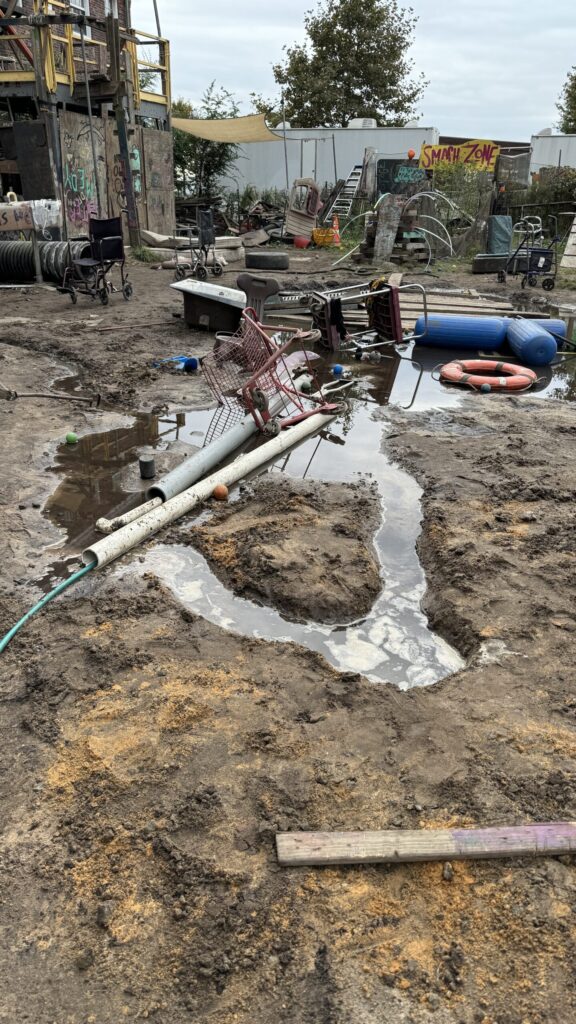
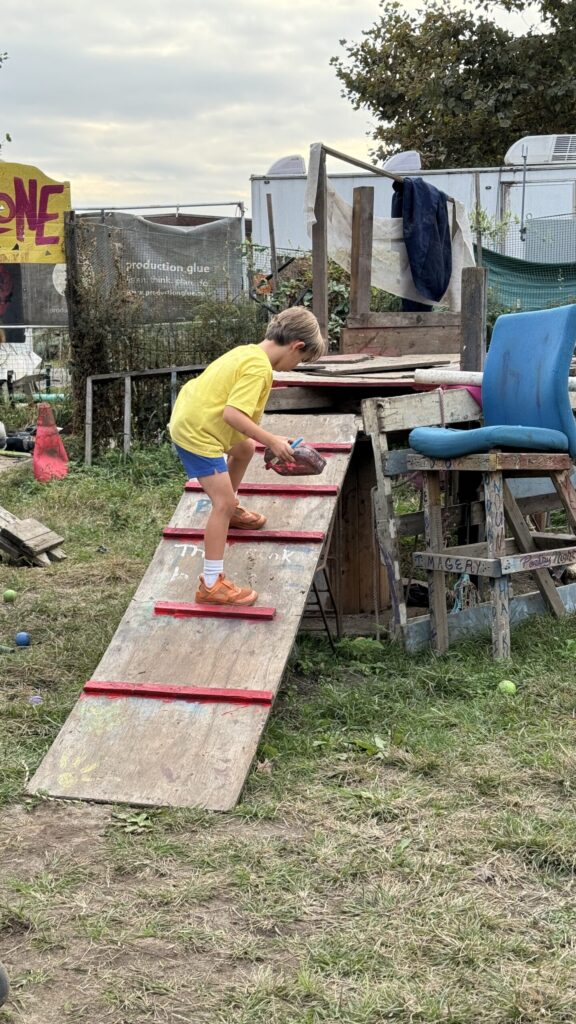
Some may have described their games and interactions (definitely the noise and frenetic-ness of their movements) as something from ‘Lord of the Flies’. In fact, many adults have the opinion that, left to their own devices, in spaces like this, children’s play ‘divulges’ into chaos. A trained Playworker sees something completely different, they see the intentionality behind the behaviours and the intricate play cues and returns within these interactions. At Educated by Nature, we have been working on mapping the flow of energy within playframes, of matching our understanding of the natural flow according to nature connection work and how these patterns of energy, interaction, connection all intertwine and follow similar and somewhat predictable patterns. What we have been working on is the way, as Playworkers, we can identify which style of intervention is needed in each moment, if at all!
The afterschool group at the Yard, on the other hand, entered the space with calm, determination, focus! So different from the school field trip classes. Their movement, although high energy in some aspects, and free, showed a comfort in the space that comes from familiarity. This space was home for them, they had connection to it and more specifically the Playworkers in it. This was their space and this feeling was palpable. I feel strongly that this difference came from a sense of ownership that the children had, given the resource of time that led to a sense of timelessness. These children were very quick to achieve flow, an important element of the Play Cycle and something that I feel many children in today’s fast-paced world don’t get to achieve often. One child painted things, all afternoon! He had a roller, a paint tray and access to paint and spent his whole afternoon making his mark on the whole space, tiny patch, by tiny patch!
Playwork Principle 4 states “For Playworkers, the play process takes precedence and Playworkers act as advocates for play when engaging with adult led agendas” and is the final element that I want to reflect on in this blog. I absolutely adored the signage that wrapped The Yard’s outside fence. This signage served two purposes. Firstly, it protected the children and play inside from peering eyes and nosy adults trying to watch what was happening in this space. But more importantly it played a part in advocating for play with statements that support play like: “For safety reasons, all adults must be accompanied by their inner child”, “Your children are fine with out advice or suggestions”, Everything for Everyone!”.
The final cherry on the top for me happened as we were on the ferry, heading back at the end of the session. A bunch of the kids asked me “So will you be back next week? are you a new playworker?” I had met them only a couple of hours earlier, yet within this time and space we had formed connections. Even as a Playworker, whose interactions with the students during their time there was limited, it was enough for them to see me as a Play Ally, an adult who is willing to stand up for their right to play and protect it!
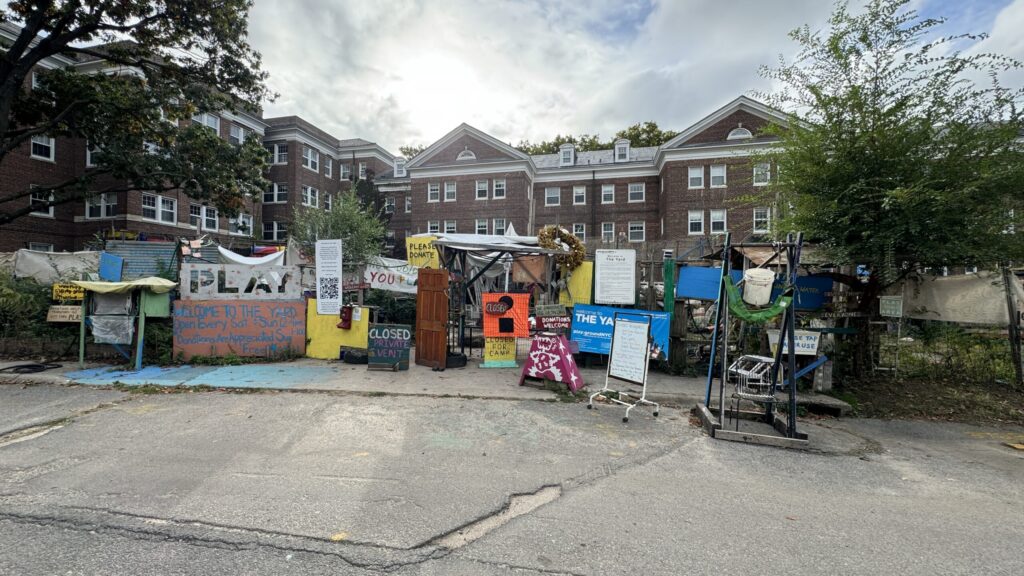
Adventure playgrounds like The Yard and pop-up spaces like KIN Village are more than just places to play – they are environments where children build resilience, creativity, and a sense of community. Witnessing The Yard’s success has strengthened my resolve to develop Perth’s first adventure playground (or Community Back Yard), a space where children can experience the same joy, freedom, and growth.
These environments are vital for children’s well-being. They give children the freedom to explore, take risks, and learn on their terms, without adult agendas. My visit to The Yard has only deepened my passion for ensuring that children in Perth have access to these transformative opportunities through play.
A huge shout out to Yoni and the team at The Yard for their passion and energy, and to the children for welcoming me into their space for a day!
